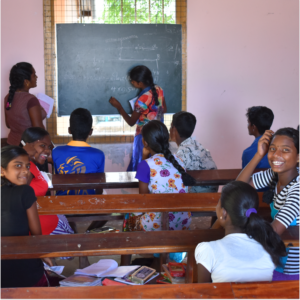15 year-old Hesandi explores the status of corporal punishment in Sri Lankan schools

As many as 80% of students say they have witnessed or been victims of corporal punishment in schools, suggesting that the legal prohibition is often ignored.
August 29, 2024
Why corporal punishment is still common in Sri Lankan schools
Corporal punishment of children as a means of discipline has been prohibited in Sri Lanka, but is still regularly used in schools, with the excuse that it is part of the country’s culture.
The Penal Code (Amendment) Act of 2016 recognised the act of punishing a child as an act of criminal force and child cruelty, but a lack of clarity and a ‘reluctance to proceed’ within courts has confused the subject.
Corporal punishment is the infliction of physical pain or discomfort with the intention of punishing someone. For many years, it has persisted as a form of discipline in Sri Lankan schools as well as in domestic settings. Hitting, caning, boxing ears, and kneeling down for extended periods (often in the sun) are some of the most common forms of punishment. These aim to cause both pain and humiliation, sometimes even for trivial reasons such as untrimmed nails.
According to the World Health Organisation (WHO), corporal punishment ‘triggers harmful psychological and physiological responses’. The consequences include threats to physical and mental health, weakened socio-emotional development, lower academic success, increased aggression and much more.
Despite this, physical punishment is a cultural norm in Sri Lanka. A very popular phrase used by many adults is “a child that is not caned is like a curry that hasn’t been stirred”.
It has not always been so widely accepted. The Chulavamsa, a historical record dating back to the 13th century, records a law banning the use of corporal punishment on both adults and children.
However, when 19th century British missionaries first established a colonial education system, corporal punishment was accepted. Since then, it has been considered the ideal form of discipline by both teachers and parents. Strict teachers who frequently utilise physical punishments are often praised for maintaining discipline.
Read more:
By UNICEF
In 2017, it was found that over 80%of students have experienced corporal punishment at least once, according to a study by Sri Lanka’s National Child Protection Authority (NCPA).
Punishments ranged from minor corrections to extreme cases where students are forced into dangerous and unethical acts.
One such incident occurred last year when a group of students from Rambukpitiya Central College were forced by their principal to eat the plastic sheets used to wrap their lunch because they had violated the school’s no plastic policy. Two of the students were hospitalised. In another incident, a nine year-old student was beaten with a musical instrument by their teacher, causing nerve damage.
However, only extreme cases where the child is physically or permanently harmed tend to become known to the public while the rest are dismissed as necessary and justifiable actions. This sentiment is used by almost all teachers who use corporal punishment since they believe it will improve the student’s behaviour.
What do students think?
Harbingers’ Magazine talked to five students from three different schools in Sri Lanka about their views on corporal punishment. For privacy reasons, unless otherwise stated the names of these students have been changed.
Amaali goes to a well-known Christian public school in Galle that has a reputation for being harsh with students. “The nuns are quite strict when it comes to following the rules and regulations. We get punished for not being able to complete our work in time. The punishments are quite severe as well,” she says.
Lihini, who attends a well-known international school, told Harbingers’ that “corporal punishment is definitely effective for discipline, but it's not good for our mental health”.
She added that the punishments had not really taught her much. She said that getting hit would not motivate her to study, but would actually stop her from doing something out of fear.
The students also noted a few positive aspects they saw in punishments. Amaali said that despite feeling resentment towards her teachers, she has grown and tries to acknowledge what the teachers were trying to do. “I understand what they were trying to teach me, so I don’t hold a grudge against them anymore. I feel like the punishments we got were totally worth it because we need to learn from our mistakes.”
She further explains how she is growing accustomed to them and feels gratitude towards these teachers. “In my opinion, although it [corporal punishment] is a pretty harsh thing, I would say that it helps a child become a better person – as it did me”.
Lihini described a sense of camaraderie that the students got from being collectively punished, despite their negative opinions of the acts: “I hate getting punished, but I kind of miss it because everyone would be punished together”.
However, Dinuli, a student from the same international school, disagrees with all forms of physical punishment. “I’m against severe punishments, so they just have to stop that kind of stuff and do the normal ones like scolding,” she stated. Dinuli continued that “making someone stand up or go out of the classroom is not that bad – just nothing that actually hurts is OK, I think. But it’s normal for teachers to hit you here in Sri Lanka. During parent meetings, parents even request teachers to hit their children.”
Harbinger’s Magazine also talked to Marije Kranabetter (real name), an international student currently living in Sri Lanka. Marije goes to a school that does not use corporal punishment. She emphasised that not being punished has benefited her mentally. “For me, knowing that I won’t be hit created a calmer environment and helped me be more confident”.
“What I’ve noticed with people who do receive corporal punishment is that they don’t really get better, but they manage to be the same and learn ways to avoid getting in trouble,” Marije shared.
Alternatives to corporal punishment
Are there any other effective ways of disciplining a child other than hitting them? This is the question often raised when the subject of corporal punishment is discussed.
Marije said: “I think explaining what you did wrong works the best because you can understand why they are mad at you and it can help you do better while still maintaining a good relationship with your teacher.” Curtis Jobe, vice principal of Galle International College, had a similar observation, stating that “for young people, they need to have an understanding of what the problem was and why there was a consequence. You can be firm, but not physical.”
The students also shared that the reason corporal punishment is so common can stem from more than it’s cultural acceptance. Aruni, another student, notes a lack of resources can contribute to a teacher’s willingness to punish. Aruni described that she has experienced more corporal punishment in public schools than international ones which are typically paid for. Her current school, an international school, does not use corporal punishment at all.
Aruni also outlined how difficult it can be to effectively control a class given how in almost all Sri Lankan public schools there are 100–200 children in every grade which is divided into classes of 40–50 students.
“There is simply not enough time for one teacher to pay attention to almost 50 children at once, while covering a heavy syllabus and also ensuring the parents that their child will have a successful academic year. Teachers have to deal with intense amounts of stress – leading them to use physical force to control children,” she explained.
This does not make the acts justifiable, by any means, Aruni added, but “the stress and pressure from their work environment causes them to take out their anger on students”.
Jobe also critiques such behaviour from teachers, saying that “adults should know how to express their disappointment and expectations without attacking”.
Nihara Sinnen is a retired teacher who has taught in many public and international schools. Speaking with Harbingers’ she shared that “children who have problems and struggle a lot are usually the ones who get beaten the most. When I see a child struggling, I get closer to them and I try to understand what their problem is.”
She notes that, in her experience, using corporal punishment on children actually leads to adverse effects as opposed to bettering the students. According to Sinnen, “even something like making a child stand up during the lesson can cause them to miss out and be humiliated”. This is one of the tamer forms of punishment in schools and even this has adverse effects in her opinion.
Legal issues
Sri Lanka’s Penal Code has denounced the use of corporal punishment in schools, but many have pointed out the flaws in the legislation itself.
Learn more:
By Daily Mirror
The Daily Mirror noted various loopholes including: ‘If corporal punishment is done in good faith, it is not illegal’ – which opens doors for illegal punishment to occur. This legal ambiguity has prompted calls for the laws governing corporal punishment to be amended or replaced entirely.
Dr Tush Wickramanayaka,chair of the Stop Child Cruelty Trust (SCCT), who has been campaigning against corporal punishment is a prominent example. She stresses ‘the need of having a child protection policy’ since ‘children do not have protection by the Government or the Human Rights Commission’.
In late April, the Sri Lankan government approved amendments banning corporal punishment to both the Penal Code and the Criminal Procedure Code.
This came in response to a study by the United Nations’ Committee on the Rights of the Child which revealed the large number of children who have been prone to physical punishments, violence and abuse in places including schools.
While Sri Lanka has taken a step forward in eradicating corporal punishment in schools, the real change must come in reversing cultural norms and beliefs.
Marije is disappointed that corporal punishment still happens in Sri Lanka, even with a law against it. Lihini had a similar reaction, stating “Seriously?! It’s illegal? I did not know that.”
The widespread acceptance of corporal punishment in Sri Lankan schools shows that change may be painstakingly slow, and collective effort will be required to protect the rights and wellbeing of students.




